
The sergeant major or píntano is a species of damselfish. It grows to a maximum length of about 22.9 centimetres (9.0 in).
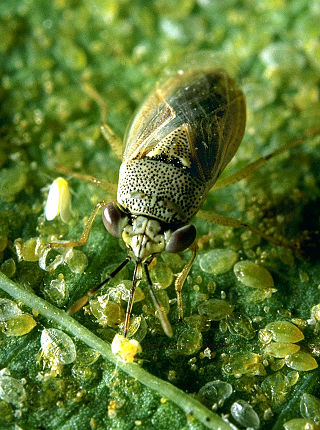
Geocoris is a genus of insects in the family Geocoridae. Commonly known as big-eyed bugs, the species in Geocoris are beneficial predators, but are often confused with the true chinch bug, which is a pest. There are more than 140 described species in Geocoris.

The Lygaeidae are a family in the Hemiptera, with more than 110 genera in four subfamilies. The family is commonly referred to as seed bugs, and less commonly, milkweed bugs, or ground bugs. However, while many of the species feed on seeds, some feed on sap (mucivory) or seed pods, others are omnivores and a few, such as the wekiu bug, are carnivores that feed exclusively on insects. Insects in this family are distributed across the world. The family was vastly larger, but numerous former subfamilies have been removed and given independent family status, including the Artheneidae, Blissidae, Cryptorhamphidae, Cymidae, Geocoridae, Heterogastridae, Ninidae, Oxycarenidae and Rhyparochromidae, which together constituted well over half of the former family.

Zicrona caerulea, common name Blue Shieldbug, is a species of bugs of the family Pentatomidae.
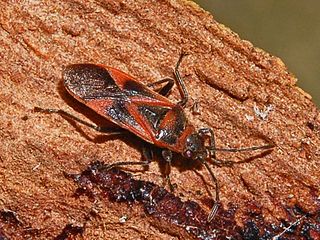
Arocatus roeselii is a species of lygaeid bug.

Eurydema oleracea is a species of shield bug in the family Pentatomidae and is commonly known as the rape bug, the crucifer shield bug, the cabbage bug or the brassica bug.

Oxycarenus lavaterae, common name lime seed bug, is a species of ground bug of the family Lygaeidae, subfamily Oxycareninae.

Spilostethus pandurus is a species of "seed bugs" belonging to the family Lygaeidae, subfamily Lygaeinae.

Tropidothorax leucopterus is a species of ground bugs belonging to the family Lygaeidae, subfamily Lygaeinae.

Lygaeus equestris, common name black-and-red-bug, is a species of ground bugs belonging to the family Lygaeidae, subfamily Lygaeinae.

Spilostethus is a genus of bugs in the family Lygaeidae. Most species in this genus are from the Palearctic and Oriental regions.
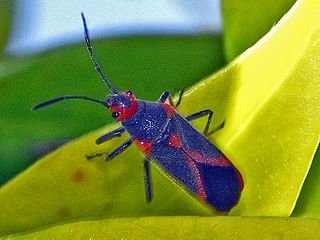
Caenocoris nerii, common name oleander seedbug, is a species of ground bugs in the insect family Lygaeidae.
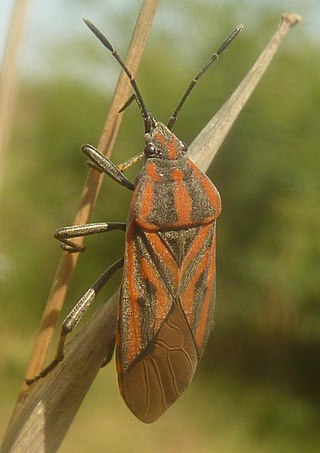
Spilostethus rivularis, the rivulet milkweed bug, is a species of bug belonging to the family Lygaeidae sensu stricto, and subfamily Lygaeinae. It is widely distributed in Africa, where it is found commonly in grassland, savannah grassland or croplands.

Arocatus melanocephalus, the elm seed bug, is a true bug in the family Lygaeidae. The species was initially described by Johan Christian Fabricius in 1798, and Maximilian Spinola designated it to be the type species of the genus Arocatus in 1837. This bug is native to Europe but has been introduced to North America.
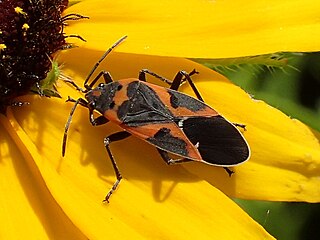
Lygaeus kalmii, known as the small milkweed bug or common milkweed bug, is a species of seed bug in the family Lygaeidae. It is found in Central and North America.

Spilostethus hospes, the darth maul bug, is a species of seed bug in the family Lygaeidae. It is found in Asia, Australasia, and Oceania. Its common name is a reference to the Star Wars character Darth Maul, who shares similar markings.
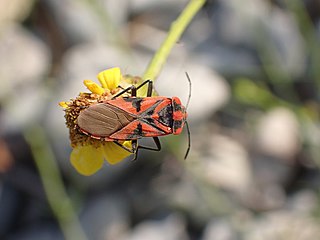
Spilostethus furcula is a species of seed bug in the family Lygaeidae, found in Africa, Europe, and the Middle East.

Spilostethus crudelis is a species of seed bug in the family Lygaeidae, found in southern Africa.
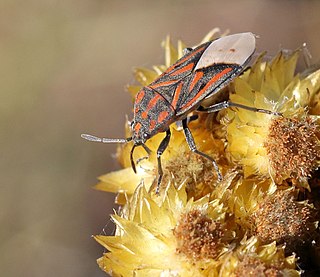
Spilostethus trilineatus is a species of seed bug in the family Lygaeidae, found in Africa and India.

Crompus opacus is a species of seed bug in the family Lygaeidae. It is a terrestrial insect found only in Australia. Crompus opacus is not currently listed under the Territory Parks and Wildlife Conservation Act 1976 in the Northern Territory of Australia.




















